Analysis On Electric Vehicle Market Research In UK
Question
Task: This assignment is worth 50% of the marks for this module and assesses learning outcome 1:
- Analyse and interpret consumer data in order to make recommendations for future strategy.
You will be allocated to a group of students, with each group being assigned an industry sector to research from the following sectors:
- Pharmaceuticals
- Electric Cars
- Domestic appliances
- Care Sector
- Computer Software
- Pottery Industry
- Confectionery
- ‘Designer Gin’
Step 1: background and context
Use secondary sources of information, such as Bloomberg, Mintel, company reports, academic and trade journals, Government statistics and news stories to research the market for your sector. Consider these points:
- What is the value of the market?
- Who are the major players and what is their market share?
- What are the key factors that affect the market (PESTEL analysis) and how marketing is conducted in this industry?
Step 2: customer analysis
Choose one of the major players. Conduct a short survey with at least 30 people who are likely to be users, consumers or customers of your category in order to find out more about their views, perceptions, opinions, attitudes and behaviour.
- Summarise your research results and analyse the segments using STP theory to identify the characteristics of different segments in this sector.
Step 3: Recommendations
- Using the results of your research make conclusions about the ‘typical’ consumer in the target segments and suggest how best to target the different segments. You need to justify your recommendations with your own data and wider reading.
Answer
Background and Context
The study on electric vehicle market research revolves around the principles to analyse the changes in electronic vehicle industry of UK. Electronic vehicle industry can be considered as one of the tremendous growing sector of the world, as the demand of electronic cars is continuously increasing. Despite of having different types of challenges, the electronic vehicles are becoming the car of choice, especially in the developed countries like UK. A sudden increase of 144% was observed in the batter electronic vehicle industry, as the number of registration reached from 15,510 in 2018 to 37, 850 in the year of 2019. On the other hand, the growth of hybrid electronic vehicle maximised by 17.1% from the previous year (Frangoul, 2020). The market share of the electric vehicle industry and hybrid electric vehicle was 1.6% and 4.2% respectively, during the initial period of 2019. Although the statistics are growing continuously, the number of electronic vehicle is still lower compared to the diesel and petrol cars.
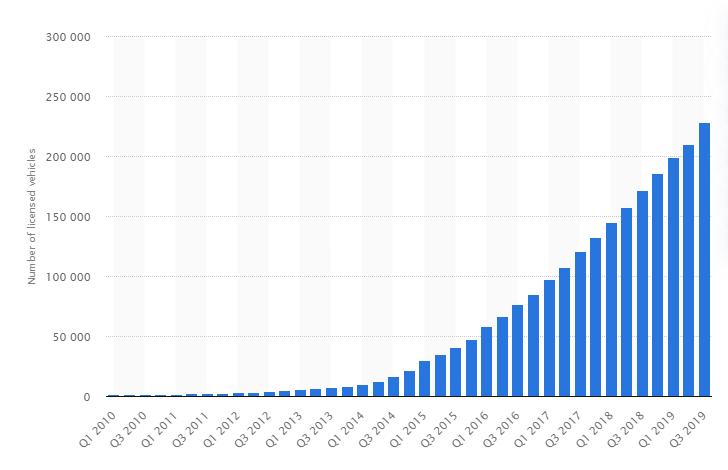
Figure 1: Number of licensed ultra-low emission cars in UK (2010-2019)
(Source: Statista, 2020)
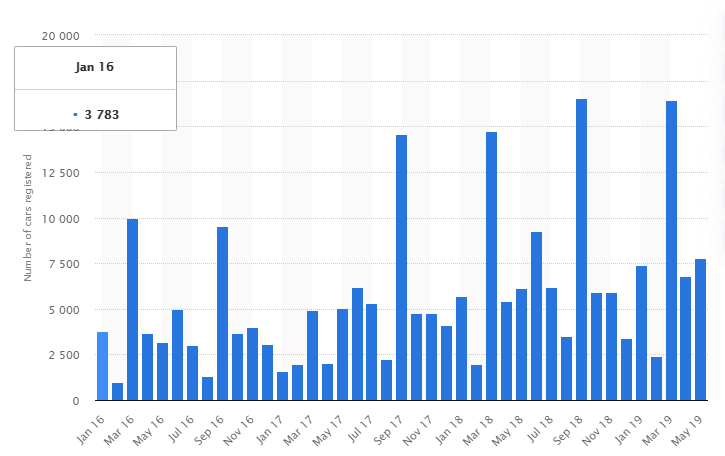
Figure 2: Number of hybrid electronic cars monthly registered in UK 2016-2019
(Source: Statista, 2020)
Different electric vehicle market research shows that the increasing growth of EV industry would be projected from an estimation of 3,269, 671 units in 2019 to 26, 951, 318 units within the year 2030. The CAGR growth of the industry would be 21.1% during this period of forecast (Allied Market Research, 2020). The market value is continuously increasing, due to its features of less emission quality. As per the report made by Deloitte, there are two major factors working behind the tremendous and increasing growth of EV industry, the first major factor is policy and regulation and the second one is customer demand. The first major factor includes fuel economy, emission standards, financial incentives, and city access restriction. It is reported that around 20 major cities of the world are going to ban the usage of diesel and gasoline cars within the year 2030. On the other hand, the customers concern about batter EV is also maximising due to the wide range of beneficial performance, full access of the city, unique interior and exterior styling, lower running cost, and quieter or safer journey (deloitte.com, 2020).
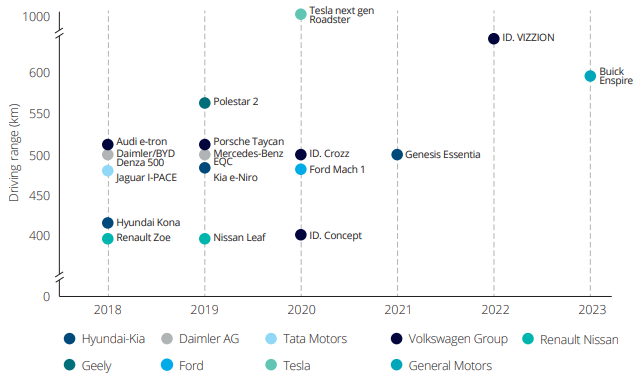
Figure 3: One of the most significant customers’ concern factor
(Source: Deloitte.com, 2020)
There are various automobile companies in UK market, who are offering different types of EVs to the consumers of UK. As shown in the above figure provided in the study of electric vehicle market research, some major players of this industry are Hyundai-Kia, Daimler AG, Tata Motors, Tesla, General Motors, Volkswagen Group, Renault Nissan, Geely, Ford, and so on (Deloitte.com, 2020). Some of the new and recent best electric cars of 2019 are Hyundai Kona Electric by Hyundai, Kia e-Niro by Kia, Mercedes EQC by Mercedes, Tesla Model 3 by Tesla, Nissan Leaf by Nissan, and so on. Tesla owns the position of UK’s top most brand in EV cars, along with the 2.2% market share in the industry, as per the 2019 September report. Hyundai Company has reached to a record hit of 3.8% market share in the current UK’s electronic vehicle market (hyundai.news, 2019). Mercedes retains a range of market share in UK market, which lies in 5.17% to 8.9%, it can be considered as a relatively higher proportion car of UK market (Statista, 2020). On the other hand, Nissan’s market share is also laid in the range of 2.64% and 6.76%, as in July 2019; the company retained a share of 3.94% in the UK market (Statista, 2020).
There are different key factors of electric vehicle market research, which have positive impacts on the growth and development of the EV industry in UK. From the political context, UK government encourages the automobile companies operating in the EV industry in making low-emission vehicles. Since the demand of emission-free or low emission vehicles have grown worldwide, therefore, the UK EV market is providing subsidy to the government for the products. Due to the lower environmental impacts, the low emission or electronic vehicles are constantly getting support from the government or political authorities (Seng, 2017). On the other hand, the economic factor is actually hitting the growth of the industry, as the whole automobile industry, including EV and normal vehicles is facing economic recession in UK market. Therefore, the high priced luxury vehicles are being affected by the deteriorated economic condition. However, the developed infrastructure of UK helped the EV industry in enhancing their market share and overall revenue as per the increasing demand. Rong et al. (2017) mentioned that the socio-cultural forces of UK residential population have changed from some of the previous years, as they are trying to make their environment sustainable; therefore, they started focusing on low emission vehicles, which ultimately increases the demand of EV.
Technological innovation is one of the main driving forces behind the increasing popularity of EV. More innovation helps in maximising the growth of market share. Due to this reason, all the EV car manufacturing companies operated in this industry focus on their research and development protocol. Kavanagh et al. (2018) reported that not only innovation in technology, customers also demand for high mileage and fuel efficient vehicles, which could only be found in electronic cars. From the environmental perspective, the electric vehicle market research always would get support, as the features of low emission, fuel efficiency, and other environmental friendliness factors increase the market value of electronic vehicles. The industry also gained authoritative support from the pollution control board due to their contribution in pollution control. Apart from the environmental laws and regulations, the industry will also positively influenced through the safety laws, product quality regulations, and tax laws, as all the factors remain properly maintained in electronic vehicles (Wu et al. 2018).
Customer analysis
Among the key players mentioned in the above section of electric vehicle market research, one of the major players of the EV industry is Tesla Motors. Tesla can be considered as one of the top brand in the UK’s electronic vehicle industry, as they have different competitive advantageous factors, which could help the company in going faster than the rival companies. The company mainly has different highly advanced technological features, for example the battery technology of Tesla. For example, the battery range could help the company in maintaining their grip on the EV market around 60%, especially during the new sales. As per the previous evidence, Tesla becomes the pioneer, who actually brought the concept of Electronic vehicle in front of people, through launching their sporty Roadster, in the year 2008. After that, they launched their first flagship EV model Model S in the year 2012, which was then followed by Model 3 in 2017, at a much affordable rate (Siddiqui, 2020).
The above description shows that the entire EV industry is undergoing through several change phase, and therefore, for understanding the changing trends of EV industry of UK, the researcher(s) has conducted an online survey of electric vehicle market research by selecting 30 consumers of Tesla. The results of the online survey is given as follows-
Q1. Do you have ever purchased any electronic vehicle from Tesla?
|
Options |
Number of respondents |
Total number of participants |
Percentage (%) |
|
Yes |
20 |
30 |
66.7 |
|
No |
10 |
30 |
33.3 |
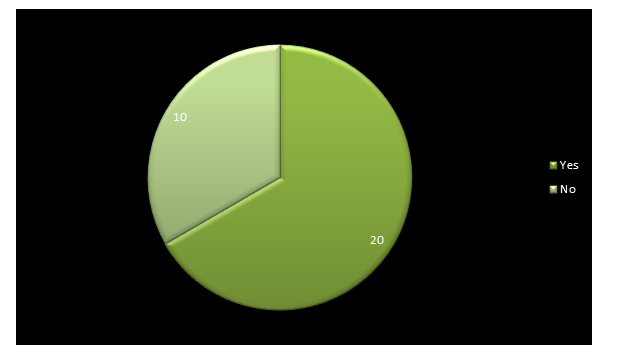
Table 1 and figure 4
Analysis: The above description on electric vehicle market research shows that among the 30 survey participants, majority percentage has owned an Electronic vehicle at least one time in their life. This statistic reflects the increment in EV acceptance rate among the UK consumers.
Q2. How far do you agree with the statement that people demand for Electronic vehicle has been increased from the last few years?
|
Options |
Number of respondents |
Total number of participants |
Percentage (%) |
|
Strongly agree |
12 |
30 |
40 |
|
Agree |
8 |
30 |
26.7 |
|
Neutral |
6 |
30 |
20 |
|
Disagree |
4 |
30 |
13.3 |
|
Strongly disagree |
0 |
30 |
0 |
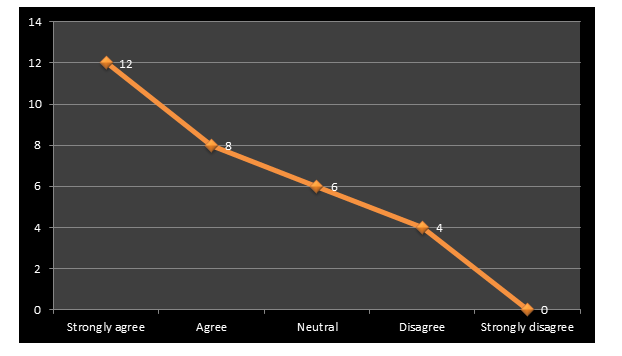
Table 2 and Figure 5
Analysis: Around 40% of the respondents stated that they agreed with the statement that the entire scenario of EV market has changed from some of the previous years. Only 13.3% respondents disagreed with the statement. The fact reflects that the tremendous changing phases of EV industry have also influenced the mindset of the customers, as they remain integrated in the operations.
Q3. What types of internal and external changes do you observe in this EV industry?
|
Options |
Number of respondents |
Total number of participants |
Percentage (%) |
|
Cost minimisation |
5 |
30 |
16.7 |
|
Technical innovation |
9 |
30 |
30 |
|
Sustainable Energy resource usage |
6 |
30 |
20 |
|
Economic up-gradation |
4 |
30 |
13.3 |
|
Steps towards full automation and robotics |
5 |
30 |
16.7 |
|
All of the above |
1 |
30 |
3.3 |
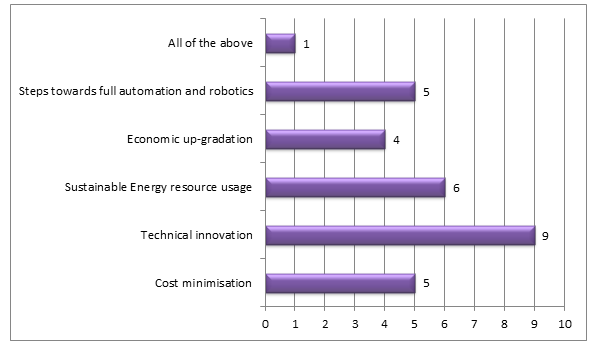
Table 3 and Figure 6
Analysis: Majority, around 30% of the consumers point out about the technical innovations, as this is the major changing factor in this industry. However, there are some other associated elements, which are also changing as per the ongoing time. Such as, 16.7% respondents stated that costs of the EVs has been minimised from the initial time, and people of upper middle class and high class could easily afford a single purchasing. 13.3% of the participants stated about the economic benefits obtained from this industry, whereas 20% mentioned about the changes in sustainable energy resources.
Q4. As per your opinion, what is the main potential issue in adopting the electric vehicle market research?
|
Options |
Number of respondents |
Total number of participants |
Percentage (%) |
|
Extreme price for middle class people |
7 |
30 |
23.3 |
|
Absence of knowledge regarding new technology |
10 |
30 |
33.3 |
|
Marketing in specific region and specific customer segment |
6 |
30 |
20 |
|
Lack of understanding about the no-emission cars and fuel economy |
4 |
30 |
13.3 |
|
All of the above |
3 |
30 |
10 |
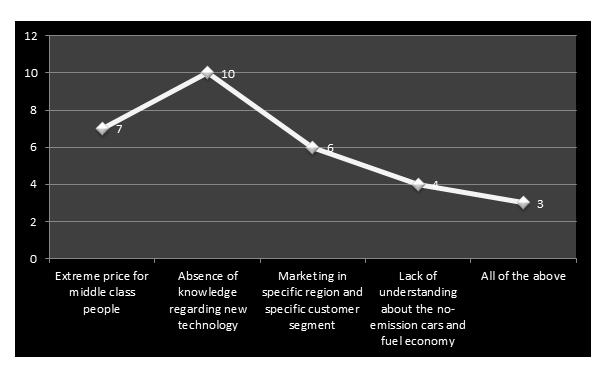
Table 4 and Figure 7
Analysis: This question on electric vehicle market research shows that although tremendous growth in the EV industry can be observed, there are several issues, which are faced by Tesla customers. 33.3% stated that they have less idea and less knowledge regarding the newly developed and included technologies, whereas 23.3% mentioned that the extreme cost of the products is the most potential issue.
From the above analysis in the context of electric vehicle market research, it can be stated that although the demand of EV manufactured by Tesla has been increased from the previous years, the segmentation and targeting of the companies is still limited to the higher class and upper middle class population. According to the STP theory, the segmentation of customers could be performed based on the psychological, geographical, and socio-economic status. For example, people living in the most hi-tech cities of UK, having higher level of income, and high standard of life are included in the customers. On the other hand, the study of electric vehicle market research signifies that the target market would be high-income people, like business tycoons, celebrities, political leaders, and so on, however, now companies also start targeting people belong from upper middle class population. Therefore, in case of positioning, it can be stated that the company has placed itself in the quadrant of high quality and high price, as they give premium quality products in higher price range (Siddiqui, 2020).
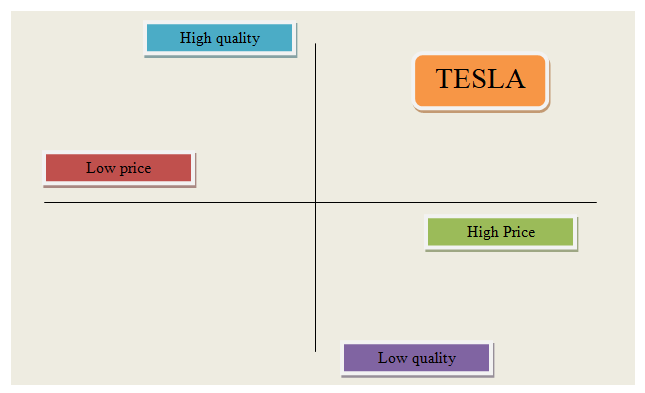
Figure 8: Position map of Tesla
(Source: Created by learner)
Recommendation
Based on the above analysis on electric vehicle market research, it can be recommended that the companies operating in EV industry of UK, including Tesla, require focusing on shifting their targets from the current customer base. The requirements of electronic vehicle are everywhere, especially due to the reason of remitting the environmental contexts. Therefore, it is necessary to manage the pricing of the EVs, for making them affordable at least for the middle class population. Apart from this, companies can diversify their products, such as manufacturing some new low emission models with less complexities of innovation. Along with this, proper media marketing is essential for reaching to the customers, as Kavanagh et al. (2018) mentioned less marketing of these products is another issue behind the lower acceptance rate.
The EV industry requires marketing their products through different promotional activities, as this will help in increasing people awareness and curiosity level about the concept of electronic cars. People often could not understand the proper usage of such complicated technologies, and therefore, they feel fear in buying such costly thing, and prefer buying the traditional fuel cars. Hence, the findings obtained from the analysis on electric vehicle market research illustrates that the companies need to focus on different EV car campaigns, where the car dealers will discuss about the benefits of EV cars, along with its positive contributions in environmental sustainability (Ziaee Bigdeli et al. 2018). They need to inform people about the facilities of low emission, fuel efficiency, and other factors of electronic vehicles.
Reference List
Allied Market Research. (2020). Electric Vehicle Market Size, Share & Growth | Industry Forecast - 2025. electric vehicle market research [online] Available at: https://www.alliedmarketresearch.com/electric-vehicle-market [Accessed 10 Jan. 2020].
deloitte.com. (2020). [online] Available at: https://www2.deloitte.com/content/dam/Deloitte/uk/Documents/manufacturing/deloitte-uk-battery-electric-vehicles.pdf [Accessed 10 Jan. 2020].
Frangoul, A. (2020). UK car sales hit 6-year low but electric vehicles see surge in demand. [online] CNBC. Available at: https://www.cnbc.com/2020/01/06/uk-car-sales-hit-6-year-low-but-electric-vehicles-see-surge-in-demand.html [Accessed 10 Jan. 2020].
hyundai.news. (2019). Hyundai Motor gains strongest ever UK market share. electric vehicle market research [online] Hyundai Media Newsroom. Available at: https://www.hyundai.news/uk/brand/hyundai-motor-gains-strongest-ever-uk-market-share/ [Accessed 10 Jan. 2020].
Kavanagh, L., Keohane, J., Garcia Cabellos, G., Lloyd, A. and Cleary, J., 2018. Global Lithium Sources—Industrial Use and Future in the Electric Vehicle Industry: A Review. Resources, 7(3), p.57.
Rong, K., Shi, Y., Shang, T., Chen, Y. and Hao, H., 2017. Organizing business ecosystems in emerging electric vehicle industry: Structure, mechanism, and integrated configuration. Energy Policy, 107, pp.234-247.
Seng, D. ed., 2017. Electronic evidence. Institute of Advanced Legal Studies.
Siddiqui, F. (2020). Teslas still go much farther on a single charge than their competitors. electric vehicle market research But the strategy carries risks. The Washington Post. [online] Available at: https://www.washingtonpost.com/technology/2020/01/10/tesla-battery-range/ [Accessed 10 Jan. 2020].
Statista. (2020). Hybrid petrol/electric cars 2016-2019 Statistic | Statista. electric vehicle market research [online] Available at: https://www.statista.com/statistics/310715/hybrid-petrol-electric-cars-registered-in-the-united-kingdom/ [Accessed 10 Jan. 2020].
Statista. (2020). Mercedes-Benz car market share 2016-2019 | Statista. [online] Available at: https://www.statista.com/statistics/300447/mercedes-benz-car-market-share-in-the-united-kingdom/ [Accessed 10 Jan. 2020].
Statista. (2020). Nissan car market share 2016-2019 | Statista. [online] Available at: https://www.statista.com/statistics/300454/nissan-car-market-share-in-the-united-kingdom/ [Accessed 10 Jan. 2020].
Statista. (2020). UK: low emission cars 2010-2019 | Statista. electric vehicle market research [online] Available at: https://www.statista.com/statistics/310475/number-of-all-low-emission-cars-in-the-united-kingdom/ [Accessed 10 Jan. 2020].
Wu, J., Yang, Z., Hu, X., Wang, H. and Huang, J., 2018. Exploring driving forces of sustainable development of China’s new energy vehicle industry: An analysis from the perspective of an innovation ecosystem. Sustainability, 10(12), p.4827.
Ziaee Bigdeli, A., Bustinza, O.F., Vendrell-Herrero, F. and Baines, T., 2018. Network positioning and risk perception in servitization: evidence from the UK road transport industry. electric vehicle market research International Journal of Production Research, 56(6), pp.2169-2183.












